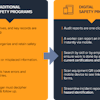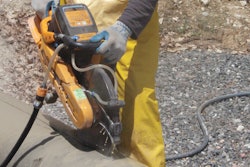
The tips presented in this article come from a well-regarded risk management expert — Jeff Copeland, a consultant who comes with quite the credentials. An engineer from Purdue University with a Master’s Degree in Business Management, Jeff was president of a large Columbus-based general contractor for many years. Upon realizing the seriousness and costs associated with poor management of risk, Jeff improved his own firm’s safety and then began assisting other companies.
Recently retired, Jeff now consults with contractors of all sizes and provides key insights to reducing their risk in construction. He has provided critical and expert testimony at many construction-related lawsuits. Considered a true industry expert in risk management, here then is my discussion with Jeff that he made possible exclusively for The Contractor’s Best Friend.
In preparing Jeff for our interview, I informed him of our previous articles, providing copies for his better understanding of our past direction. A few of his safety tips have been addressed in our previous articles, a few have not, and it is these tips that we’ll expand on for your firm’s benefit.
Brad: Jeff, first of all, welcome to The Contractor’s Best Friend audience and thanks for making some time for us.
Jeff: Well thank you, Brad. I’m all for helping any construction owner and leader who is out to protect his or her company, people and projects.
Brad: Well, let’s get right to it. If you could provide 10 tips to contractors of all specialties to manage their risk better, what would you include on that list?
Jeff: I think there’s probably more than 10, but let’s start there and perhaps we can provide additional insights in a later series on risk management. Let me share the 10 right out of the shoot and then we can go back and expand on those that you feel might be of greater importance to your readers.
- Safety — Be proactive! Bad Workers Comp ratings or OSHA fines can put you out of business.
- Collect your receivables. Know the billing cycles and don’t be late. Being a couple of days late with your bill can delay your payments an additional 30 days.
- Know the language of your contract as well as the GC’s contract with the owner.
- Understand the difference between “Pay if paid” vs. “Pay when paid.” The interpretation can vary state to state so talk to your lawyer if you have any doubts or questions.
- Retainage requirements. If you are one of the early subcontractors on the project, push for early partial release.
- Levels of authority
- Change notice requirements
- Bid work within your competency. Don’t “experiment” bidding work you don’t have the experience to perform.
- Participate in the development of the “for construction” schedule. Don’t let someone else tell you how to manage your company.
- Don’t wait until your work is done to start “As-Builts” and “operations-and-maintenance” manuals. It will slow down when you will get paid.
- Train your field leaders. Labor is usually your most expensive cost and the cost that can turn a good job into a loser.
- Keep learning. Join your trade association and take advantage of their training programs. Push for more education on risk management for contractors in your same field or size of company.
- Make sure the Site Access Plan does not cause you to handle your materials multiple times.
- Make sure your field people know the drawings and fight for the change order’s you deserve.
Brad: OK, that’s a pretty exhaustive list to begin with. Let’s go back and expand on a few of the items for greater understanding and benefit. First, thanks for reminding us as to the seriousness of poor Workers Comp ratings and OSHA fines.
Jeff: It’s huge! Trust me when I say that most hardworking and well-intentioned contractors pay secondary attention to some of their safety efforts…until they get nailed. My advice to your readers is to work hard at making everything their workers do easier, from a safety perspective. Look, I don’t like it either but the agents or inspectors for both Workers Comp and OSHA are not messing around anymore. I’ve seen some very good contractors who have been severely punished and fined for taking a less-than-high-priority approach to implementing safe work processes and requirements. A clean, safe site is a more productive site no matter whether you are an asphalt paver, a flatwork concrete expert or an electrician.
Brad: What about your second tip, the one involving collecting your receivables and knowing the billing cycles. I assume you are referring to the billing cycles of the customer? Is this a tip for safety?
Jeff: It’s actually part of the bigger picture of risk management. Remember, risk management is about managing any risk that can place a contractor in a financial difficulty. Now, referring to your first reference, are receivables and billing cycles related to our focus on safety? I think they are, and let me briefly explain why.
I’ve worked with contractors who don’t do a very good job getting their receivables handled promptly or their billings were always a bit later than they should be. This often is a symptom of a contractor who is not disciplined. And if a contractor is not disciplined in such things as billings and accounts receivables why wouldn’t he also be less disciplined in the area of protecting his workers and company? I have found a real connection here for some contractors.
Brad: Jeff, your third tip is really interesting and looks complicated. I’m not sure that many of the readers of The Contractor’s Best Friend have to deal with some of the items you have shared. Can you maybe shed a little light on how this might apply to a smaller contractor, perhaps one that does not work directly for a GC but rather works directly for a customer such as a property manager of apartments or a residential home owner?
Jeff: I would admit there might very well be some differences concerning my “contract language” tip for the subtrade professional who as a rule does not work with general contractors. However, no matter who you are I do think it wise to really understand the contracts that you are entering into. I don’t think it’s a secret that our country is less afraid to sue another person and contractors are probably close to the top of that list.
One additional insight if you are a contractor who is working for a general contractor or construction manager: Pay close attention to the payment conditions. I’ve seen many subcontractors, very respectable contractors, sign a contract with a GC only to have overlooked the terms of payment. They signed the contract because they needed the work to keep their own crews busy, but they either neglected or purposely overlooked the provision in the contract that they would not be paid until the GC was paid. This often stretched receiving their payments for three to six months and, in a few cases, a year! There are owners today who sign a contract with a GC or CM that says they won’t get paid in “less than 60 days.” Can you afford to finance the project that long?
Brad: Let’s look at your fifth tip. Don’t contractors have better things to do than sit in scheduling meetings? How important is that, really?
Jeff: Again, it’s HUGE! Even if you are a contractor who does work directly for your customer and not a GC or CM, it is important that you are directly involved in the development of the schedule. Brad, I know you’ve educated me on the use of your Next Week Look Ahead; in fact, I know the company I led for years is using a version of your scheduling format. It is just critical for the smallest of contractors to be diligent about scheduling their work for a customer. You can’t afford to have idle time for your field crews.
Brad: What about the contractor who might complete more than one job a day or complete several in a week’s time?
Jeff: More jobs completed means more things at risk by not managing crews, the crews’ efforts and focus, and certainly the safety risk inherent with just strapping down equipment and tools and transporting people, equipment, tools and materials across town. I have found that the smaller the contractor the more at risk he or she is putting the company IF they DON’T schedule their work.
One additional thought on this point, Brad. If a contractor is, by size, smaller and dependent on more volume of work completed each week then they are most likely working with customers who are not going to require a schedule of work. Certainly the big commercial jobs that have multiple contractors engaged with a single site require in their contracts that contractors provide for or participate in developing the schedule. However, my advice to the “little guy” is just as serious: Schedule every job your crews complete…no matter the size!
Brad: Jeff, your tip number six refers to “As-Builts” and “operations & maintenance” manuals. I’m not sure that this applies to all of our Contractor’s Best Friend readers. Is there still something for the specialty contractor to take away?
Jeff: While the specialty contractor may not be required to complete “As-Builts” or “O&Ms” for work completed, the lesson here is to educate customers on what things were completed, how they were completed and recommend maintenance efforts for long-term satisfaction. This is a great opportunity to market your company and future services. Also, such an effort can prevent any customer from coming back in a threatening way and raising questions in anger about information that could have been provided easily.
Brad: OK, then for the small contractor, could a simple description of what a customer can do to maintain the recently completed work suffice? For example, maybe the flat work concrete company who put in a new parking lot for a strip mall might provide some documentation that would educate the customer on how to best maintain the lot to get the maximum life?
Jeff: I would think that would be a great step in the right direction to manage any future risk, not to mention providing greater service to your customer.
Brad: OK, Jeff, your seventh and eighth tips are interesting, as I’ve addressed these educational tips in previous articles. Without repeating some of the insights I have already provided our readers, can you expand on training and learning?
Jeff: Education is simply the only way we’re really going to win the risk management game. The contractor who consistently educates his or her employees to performing work smarter and safer will “win” in the end. Fines and discipline are needed, of course, for contractors who are trying to cut their costs and essentially making the playing field uneven. But at the heart of any real success, both in safety and in maintaining a profitable business, education is the first place I would start.
Without being too obviously promotional for what you do, Brad, I would highly recommend that contractors bring in outside consultants like you (and me) to educate their leaders and workers on risk management efforts. Now, a great source of this education can be found easily in the many contractor associations that are now prevalent. There just isn’t any excuse anymore about getting all the information you can to build a better, growing, safer and more profitable company.
And one more point that I think is important. I know earlier I made reference to OSHA fines. Look, because so much information and so many resources are available today for contractors, most local, state and federal agencies do not have the patience or tolerance that they once had. So, if you desire to grow your construction business you had better take another serious look at the entire risk management arena.
Brad: Thanks, Jeff. Let’s look at your last two tips. I think they are both great as they relate to risk management. The ninth tip really supports the “looking for stuff” reality that many contractors contend with from their workers.
Jeff: Yes, I’ve heard you address this growing problem before and as it relates to multiple handling and transporting on a jobsite, there’s not a more costly “disease” for contractors to address. Again, thinking of the smaller contractor who completes several jobs in a day or week, the need for a site plan may be more critical than even for the larger contractor who might be on a jobsite for days or weeks at a time.
Let me simply say, no matter who you perform work for, be sure to have a clear understanding of how your crews and suppliers are to access the worksite. I have always recommended documenting this effort, too, as it is amazing how quickly a customer, including the GC (and I was one!), can forget to what he had agreed to in an earlier conversation.
Brad: Jeff, your tenth and final tip addresses change orders. I have written about this great need on earlier occasions but COs is still a topic that just doesn’t permeate enough of the specialty construction market. Can you address this very important item?
Jeff: In a word, change orders represent money! We hear a lot about contractors bidding work at lower profits than ever, but what we don’t always hear enough about is that customers are changing their minds more than ever. A brief example is worth the time here.
Let’s say a property manager of condominiums contracts with a specialty contractor, let’s say a full service pavement maintenance contractor. Under the contract, the contractor is to pave, put in curb and gutters, stripe, seal and replace all of the trash dumpster pads. I mean, he’s got the entire enchilada of work to perform. Now, the contractor had to bid the work very cheap to get the job, and the property manager was very cautious about how much he was allowed to spend.
Now, after the contractor starts working the owner of the condos stops by to see how the work is going. He sees a few additional areas needing work and informs his manager to talk to the contractor about doing additional work. When the manager approaches the contractor about the changes the contractor, not wanting to disappoint the manager and raise uncomfortable questions to ask the owner, quickly agrees to the changes. The contractor figures he might make some minor adjustments on his end but realizes that he may be giving away a few thousand dollars of profit to comply with the request.
What should happen here is that the contractor should very clearly state that he will be more than happy to complete the additional changes BUT only after a formal change order is completed. You are talking about managing a huge risk of profitability! I’ve heard hundreds of stories about contractors who either made a lot less profit or actually lost money because they performed additional work, outside the contractual directions.
Brad: Thanks Jeff! Great example and a great reminder of how critical it is that any change to the original contract be clearly specified — along with a specific price for the additional services — and signed before completing any work. We need to stop giving away work, which is really giving away profit!
As you can tell from our interview, risk management is really about more than just “safety.” For the general contractor, project manager or superintendent at a larger contractor, many of the issues addressed by Jeff Copeland the last two weeks are not new. The issues may or may not be effectively addressed in their company, but they most likely have experienced some or all of these issues before.
However for the contractor reading this article who is recognizing these risks for the first time, don’t leave your reading with anything less than a commitment to make sure you are cleaning up the risk that your company might be experiencing. Risk management really is HUGE!
Here’s to a less risky effort in managing your company!



















